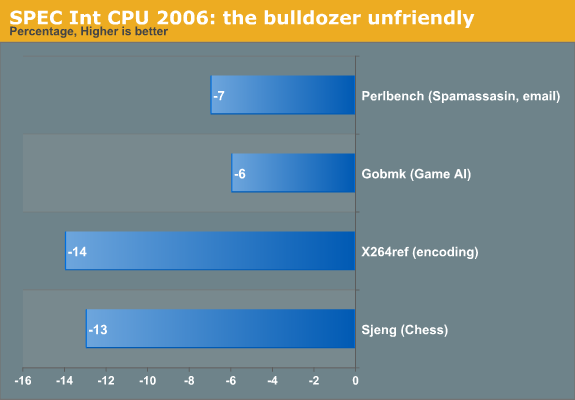The Bulldozer Aftermath: Delving Even Deeper
by Johan De Gelas on May 30, 2012 1:15 AM ESTZooming in on SPEC CPU2006: the Bad
The optimized SPEC CPU2006 int binaries allow gains in the range of 30% to 117%. Unfortunately the complete benchmark suite only shows a gain of 21% when we compare the Opteron 6276 with the 6176. Closer inspection shows that four benchmarks regress. The regression appears to be small in most benchmarks (7 to 14%), but remember that we have 33% more cores. Even a small regression of 7% means that we are losing up to 30% of the previous architecture's single-threaded performance!

Perlbench has high locality in the L1 and L2 caches and rarely accesses the Last Level Cache, let alone the memory. The result is a benchmark that delivers high IPC: 1.67 on a five year old Core 2 Duo ("Merom"), and close to +/- 1.9 IPC on the latest Intel CPUs. The interesting thing to note is that h264ref and Perlbench are among the top IPC performers in the SPEC CPU2006 suite.
Sjeng (chess) and Gobmk are both Artificial Intelligence subroutines. Again, the IPC is relatively high (>1), but their most important performance characteristic is that they contain a very high percentage of hard to predict branches: twice the average of the SPEC CPU integer suite.
Granted, the evidence we've presented is still circumstantial. It would take an extremely long and intensive profiling session on all new processors to really determine what is going on, and that is beyond our time budget: one SPEC CPU run alone consumes a whole day. However, we did get our hands dirty. A short profiling session on three different benchmarks gives us some very interesting results that we want to discuss next.










84 Comments
View All Comments
Taft12 - Wednesday, May 30, 2012 - link
Johan, this is the best article I've read on Anandtech in quite some time, even better than Jarred, Ryan and Anand have come up with lately.The level of analysis goes far, far beyond just what the benchmarks show.
Bravo!
JohanAnandtech - Thursday, May 31, 2012 - link
Great! Good to read there are still people that like these kinds of analysis!:-)
ct760ster - Wednesday, May 30, 2012 - link
Would be interesting if they could test the aforementioned benchmark in an OS with a customizable kernel like GNU-Linux since code optimization is not possible in most of the proprietary format benchmark.alpha754293 - Wednesday, May 30, 2012 - link
What about the lacklustre FPU performance?The very fact that the FP has to be shared between two integer cores and as far as I know, it cannot run two FP threads at the same time, so for a lot of HPC/computationally heavy workloads - Bulldozer takes a HUGE performance hit. (almost regardless of anything/everything else; although yes, it counts, but remembering that CPUs are glorified calculators, when you take out one of the lanes of the highway and two-lane traffic is now squeezed down to one lane, it's bound to get slower.)
The_Countess - Wednesday, May 30, 2012 - link
except the FP CAN run 2 threads at the same time.only for the as yet pretty much unused 256bit instructions does it need the whole FP unit per clock.
in fact the FP can run 2 threads of 128bit, or 4 even of 64bit.
and a single CPU can use 2x128bit or both can use 1x128.
intel and AMD previously had only 1x128bit capability per core.
so there is no regression in FP performance per core. its just much more flexible.
Zoomer - Wednesday, May 30, 2012 - link
FPU throughput is much more irrelevant nowadays, as many FP intensive HPC computations have already been ported to GPUs. Yes, there may be instances where there might be FP heavy and branchy, not easily parallelization or otherwise unsuitable, but such beasts are few and far between. I can't think of any, to be honest.Iger - Wednesday, May 30, 2012 - link
Thanks a lot, that was a very interesting read!Rael - Wednesday, May 30, 2012 - link
AMD should fire all its marketing department, because these guys accustomed to lie at every announcement they make. The performance gains are multiplied by five or ten, and the per-core advancement, which is close to zero, is presented as 'significant'.I don't believe these announcements anymore.
jabber - Wednesday, May 30, 2012 - link
What the whole of the AMD Marketing team?Thats Tim the caretaker and Trisha on the front desk isnt it?
I thought AMD's marketing budget was around $42.
kyuu - Wednesday, May 30, 2012 - link
Oh hai. You must be new to the human race. Marketing and "stretching the truth" have been synonymous since... forever. AMD is hardly exceptional in this regard. Stop believing anything any marketing department sells you, period.